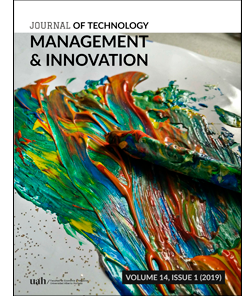Project Risk Management Implementation in SMEs: A Case Study from Italy
DOI:
https://doi.org/10.4067/S0718-27242019000100003Keywords:
project risk management, project management, small and medium-sized enterprises, empirical framework, case studyAbstract
Despite its strategical importance, the diffusion of Project Risk Management (PRM) is limited mainly to large companies, leaving a lack of empirical evidence addressing small and medium-sized enterprises (SMEs). Therefore, the objective of this paper is to analyse how to adopt PRM in SMEs with a positive cost-benefit ratio, considering risk management (RM) phases, activities, tools, instruments, procedures and organisational aspects that enable the effective implementation of PRM in SMEs. To identify the fundamental dimensions to insert in the framework, a systematic literature review was performed, and a pilot case study was conducted to test the validity of the empirical framework and improve it. Moreover, after the case analysis, the benefits obtained and the difficulties faced through the adoption of PRM are presented and discussed.Downloads
References
Badri, A. (2015). The Challenge of Integrating OHS into Industrial Project Risk Management: Proposal of a Methodological Approach to Guide Future Research (Case of Mining Projects in Quebec, Canada). Minerals, 5(2), 314-334.
Bajo, J., Borrajo, M. L., De Paz, J. F., Corchado, J. M., & Pellicer, M. A. (2012). A multi-agent system for web-based risk management in small and medium business. Expert Systems with Applications, 39(8), 6921-6931.
Blanc Alquier, A. M., & Lagasse Tignol, M. H. (2006). Risk management in small-and medium-sized enterprises. Production Planning & Control, 17(3), 273-282.
Borge, D. (2002). The Book of Risk. New York, USA: John Wiley & Sons.
Cagliano, A. C., Grimaldi, S., & Rafele, C. (2015). Choosing project risk management techniques. A theoretical framework. Journal of Risk Research, 18(2), 232-248.
Carvalho, M. M. D., & Rabechini Junior, R. (2015). Impact of risk management on project performance: the importance of soft skills. International Journal of Production Research, 53(2), 321-340.
Dalcher, D. (2012). The nature of project management: a reflection on the anatomy of major projects by Morris and Hough. International Journal of Managing Projects in Business 5 (4), 643-660.
Dallago, B., Guglielmetti, C., & Rondinelli, M. (2012). The consequences of the international crisis for European SMEs: vulnerability and resilience (vol. 27). Routledge.
Dey, P. K. (2012). Project risk management using multiple criteria decision-making technique and decision tree analysis: a case study of Indian oil refinery. Production Planning & Control 23 (12), 903-921.
Elkington, P., & Smallman, C. (2000). Managing Project Risks: a case study from the utilities sector. International Journal of Project Management, 20(1), 49-57.
Fernando, Y., Walters, T., Ismail, M. N., Seo, Y. W., & Kaimasu, M. (2018). Managing project success using project risk and green supply chain management: A survey of automotive industry. International Journal of Managing Projects in Business, 11(2), 332-365.
Henschel, T. (2006). Risk management practices in German SMEs: an empirical investigation. Int. J. Entrepreneurship and Small Business, 3(5), 554-571.
ISO21500. (2012). Guidance on project management. International Organization for Standardization. http://www.iso.org.
ISO31000. (2009). International Organisation of Standardisation. Principles and generic guidelines on risk management. http://www.iso.org.
Kim, Y., & Vonortas, N. S. (2014). Managing risk in the formative years: Evidence from young enterprises in Europe. Technovation, 34(8), 454-465.
Marcelino-Sádaba, S., Pérez-Ezcurdia, A., Lazcano, A. M., & Villanueva, P. (2014). Project risk management methodology for small firms. International Journal of Project Management, 32(2), 327-340.
Miklosik, A. (2015). Improving project management performance through capability maturity measurement. Procedia Economics and Finance, 3, 522-530.
PMI. (2013). A Guide to Project Management Body of Knowledge: PMBoK Guide (Fifth Edition). Project Management Institute. USA.
PMI. (2017). A Guide to Project Management Body of Knowledge: PMBoK Guide (Sixth Edition). Project Management Institute. USA.
Radner, R., & Shepp, L. (1996). Risk vs. profit potential: A model for corporate strategy. Journal of economic dynamics and Control, 20(8), 1373-1393.
Radnor, Z., & Walley, P. (2008). Learning to walk before we try to run: adapting lean for the public sector. Public money and management, 28(1), 13-20.
Raz, T., & Michael, E. (2001). Use and benefits of tools for project risk management. International journal of project management, 19(1), 9-17.
Shenhar, A. J., Milosevic, D., Dvir, D., & Thamhain, H. (2007 (September)). Linking project management to business strategy. Project Management Institute.
Srivannaboon, S., & Milosevic, D. Z. (2006). A two-way influence between business strategy and project management. International journal of project management, 24(6), 493-505.
Turner, J. R., Ledwith, A., & Kelly, J. (2010). Project management in small to medium-sized enterprises: matching processes to the nature of the firm. International Journal of Project Management, 28(8), 744-755.
Verbano, C., & Venturini, K. (2011). Development paths of risk management: approaches, methods and fields of application. Journal of Risk Research, 14(5), 519-550.
Voss, C., Tsikriktsis, N., & Frohlich, M. (2002). Case research in operations management. International journal of operations & production management, 22(2), 195-219.
Yin, R. (1994). Case study research: design and methods. Newbury Park: SAGE Publications.
Downloads
Published
How to Cite
Issue
Section
License







